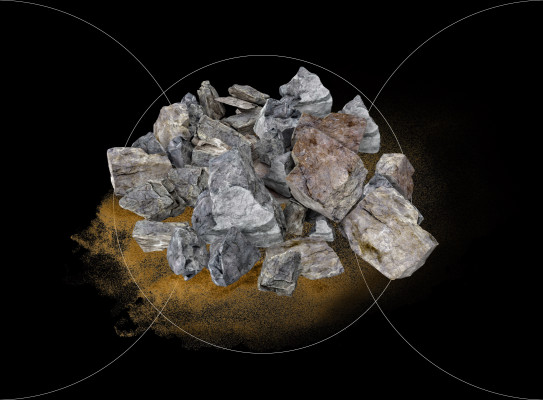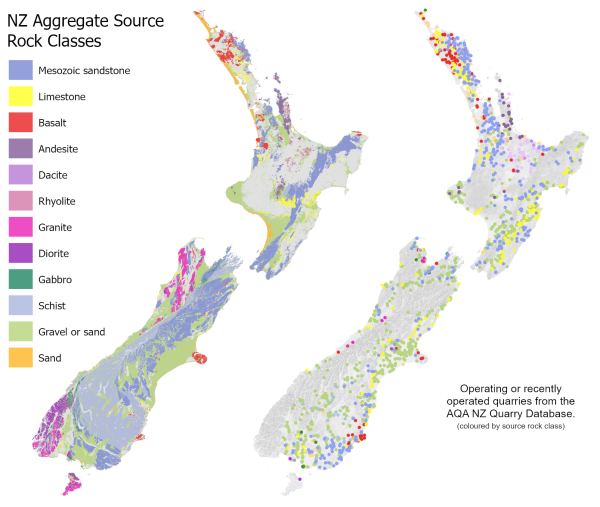Aggregate and Sand

Aggregate and sand are essential raw materials for construction, infrastructure, and industry, providing the foundation for roads, buildings, and concrete production. These materials, derived from crushed rock, riverbeds, and coastal deposits, are among the most widely used geological resources in the world.
Key Uses of Aggregate and Sand
Construction and Infrastructure
- Primary components in concrete and asphalt, essential for roads, bridges, tunnels, and buildings.
- Used as fill material in land development, foundations, and flood protection.
- Provides structural stability in railway ballast and coastal erosion control.
Manufacturing and Industry
- Glass production relies on high-purity silica sand.
- Silica sand is used in electronics, ceramics, and water filtration.
- Crushed aggregate is a raw material in cement manufacturing.
Environmental Energy Applications
- Sand is used in water purification systems and waste treatment.
- Plays a role in solar panel production (silicon extraction from quartz sand).
- Used in fracking operations to enhance oil and gas extraction (frac sand).
Geological Sources
Aggregate and sand are sourced from:
- Hard rock quarries (crushed stone, basalt, greywacke, limestone).
- River and coastal deposits (sand, gravel, marine aggregates).
- Glacial and wind-blown deposits (e.g., dune sands).
Why Aggregate and Sand are Critical
- Essential for modern construction—no roads, bridges, or buildings exist without them.
- Vital for manufacturing and clean technology, including glass, filtration, and solar panels.
- High demand and local supply issues make sustainable sourcing crucial.
As the backbone of urban development and infrastructure, aggregate and sand remain indispensable to human civilisation.
Aggregate and Sand in New Zealand
New Zealand is fortunate to have large and accessible deposits of rock and gravel throughout the country, but not all resources are economically viable. The feasibility of developing an aggregate resource depends on three key factors: accessibility, quality, and proximity to demand. Transport costs are a major concern—moving aggregate 30 km can double its cost—so resources near urban centres are highly valued but increasingly scarce due to competing land uses.
Sources and Production of Aggregate
- Greywacke, a hard, layered sandstone and siltstone, is the dominant source rock and is quarried extensively, particularly in the North Island.
- Gravel deposits from river systems and glacial deposits provide major supplies, especially in Canterbury, West Coast, Southland, Kāpiti Coast, and Hawke’s Bay.
- Volcanic rocks, mainly andesite and basalt, are quarried in some regions, particularly in the North Island.
- Production in 2022 was estimated at 47.9 Mt, but official reports only captured about 54% of the total.
- The industry is a mix of large companies with major operations and numerous smaller quarries that serve local demand.

View our aggregate critical minerals web map(external link) to see the current AQA NZ Quarry Database.
Uses of Aggregate and Sand
Aggregate is a critical material for infrastructure, construction, and transportation networks:
- Road construction and maintenance account for over half of New Zealand’s aggregate use. High-quality aggregate is used in chipseal and asphalt, while large volumes go into sub-base and base-course layers.
- Concrete and building materials rely heavily on aggregate, especially for urban expansion in cities like Auckland and Christchurch.
- Recycled materials from road aggregate and concrete are increasingly used to reduce waste and improve sustainability.
Challenges Facing the Aggregate Industry
Urbanisation and Land Use Conflicts
- Aggregate quarries must be near major transport routes and close to cities to be cost-effective, but urban expansion is forcing some quarries to close and preventing the establishment of new ones.
- Auckland, with its large population and high aggregate demand, is already transporting material from further afield as local quarries are being depleted.
- Taranaki and Gisborne lack high-quality rock deposits, making supply more challenging.
Environmental and Social Constraints
- Community concerns over dust, noise, heavy truck traffic, and the visual impact of quarries create resistance to new developments, especially in urban-fringe areas.
- Reverse sensitivity issues occur when new residential developments are built near existing quarries, leading to complaints and potential restrictions on operations.
- Offshore sand mining has been largely discontinued due to environmental concerns, particularly fears of coastal erosion, prompting a shift toward crushed rock-derived sand.
Future Resource Management
GIS-based modelling is being used to map “aggregate opportunity zones,” integrating factors such as:
- Geological suitability
- Land use constraints (e.g. conservation land, urban areas)
- Infrastructure (e.g. roads, rail, electricity, workforce availability)
- Cultural and social sensitivities
- Planning policies must ensure that aggregate resources are protected for future use before urban expansion restricts access
View our aggregate critical minerals web map(external link) to see the aggreate opportunity model results.
Additional Reading
Black PM. 2009. Geologic inventory of North Island aggregate resources: influences on engineering materials properties [draft]. [Wellington] (NZ): Aggregate & Quarry Association (AQA); [accessed 2024 Jun]. www.aqa.org.nz/uploads/files/North%20Island%20Geological%20Inventory%202009.pdf(external link)
Black PM. 2014. South Island aggregate inventory: geological influences on materials properties [draft]. [Wellington] (NZ): Aggregate & Quarry Association (AQA); [accessed 2024 Jun]. www.aqa.org.nz/uploads/files/South%20Island%20Geological%20Inventory%202014.pdf(external link)
Hill MP. 2021. Aggregate opportunity modelling for New Zealand. Lower Hutt (NZ): GNS Science. 106 p. (GNS Science report; 2021/10). https://doi.org/10.21420/1RKC-QB05(external link)
Hill MP, Chilton MO. 2024a. Aggregate Opportunity Modelling for the Wellington Region of New Zealand. Lower Hutt (NZ): GNS Science. 20 p. (GNS Science report; 2024/09). https://doi.org/10.21420/JW09-RF66(external link)
Hill MP, Chilton MO. 2024b. Aggregate Opportunity Modelling for the Bay of Plenty area of New Zealand. Lower Hutt (NZ): GNS Science. 22 p. (GNS Science report; 2024/10). https://doi.org/10.21420/W34K-RR18(external link)
Hill MP, Chilton MO. 2024c. Aggregate Opportunity Modelling for the northern Auckland area of New Zealand. Lower Hutt (NZ): GNS Science. 23 p. (GNS Science report; 2024/11). https://doi.org/10.21420/DS28-ZG73(external link)
Hill MP, Chilton MO. 2024d. Aggregate Opportunity Modelling for the southern Auckland area of New Zealand. Lower Hutt (NZ): GNS Science. 22 p. (GNS Science report; 2024/12). https://doi.org/10.21420/J47S-NN09(external link)
Hill MP, Chilton MO. 2024e. Aggregate Opportunity Modelling for central and northwestern Otago area of New Zealand. Lower Hutt (NZ): GNS Science. 23 p. (GNS Science report; 2024/13). https://doi.org/10.21420/RFGE-SQ76(external link)
